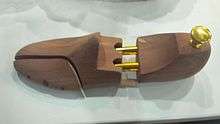Shoe tree

A shoe tree is a device approximating the shape of a foot that is placed inside a shoe to preserve its shape, stop it from developing creases and thereby extend the life of the shoe. It is a reusable alternative to wadded rags or newspapers.
Perhaps more important than maintaining the shape, shoe trees also play a crucial part of wicking away leather-damaging moisture from the inside. This is especially important when shoes are worn without socks, as the sweat absorbed by the leather can lead to lining rot.[1]
Higher quality shoe trees are made from solid wood, usually cedar, which helps control odor and absorb moisture. Other materials include beech, lime and alderwood. Although most shoe tree manufacturers claim that cedarwood is superior, there is really no difference as long as the shoe tree is made of unfinished wood.[2]
Types
Among wooden shoe trees, there are generally three categories, which correspond to price and quality.
Spring shoe trees

The cheapest are wooden shoe tree without a full heel. Although they help with odor, and will help preserve the original shape at the front of the shoe, the narrow knob on the heel puts excess pressure on one section of the heel and prolonged use may deform the shoe.[2]
Advanced shoe trees

Mid-range shoe trees have a full articulated (usually rounded) heel and sometimes have ventilation slots in the toe to help moisture evaporate. These are usually made of 3 parts: a heel, a head, and a smaller toe piece. These approximate the shape of your feet, so they are better at maintaining the structural integrity of your shoe compared to generically shaped shoe trees.
Lasted shoe trees
At the highest range are lasted shoe trees, which accompany the shoes for which they have the same last.[3]
Plastic shoe trees
Shoe trees may also be made of plastic or stamped sheet metal, with or without a coiled steel spring stem; these are typically cheaper, lighter, and are better suited for travelling. Types lacking a flexing steel spring may use extension springs or adjustable two-piece stems having an over-centre mechanical action to wedge them in place. Plastic shoe trees maintain the shape of your shoes, but lack the moisture absorbing qualities of wooden shoe trees.
When to use
You should insert shoe trees once you take your shoes off so that they can absorb the moisture from your sweat and dry out your shoe in the correct shape. This will prevent lining rot and creases from taking hold of your leather. You should also insert shoe trees if you wet your shoes so that they can dry out faster.[4] While some recommend having a pair of shoe trees for every shoe,[1] others believe they are unnecessary once they have done their job of absorbing moisture, typically after 24 hours of 'rest'.[2][3]
Boot trees
Boot trees are shoe trees for boots. Creases that form in the calves of boots can eventually cause zips to break, and a zip replacement can be an expensive repair. By investing in a pair of boot trees a repair like this can easily be avoided.
A boot tree that’s two sided with a centre support bracket expands to provide the ideal tension for your boots. Some boot trees come with a trigger that allows easy fitting – and easy hanging.[5]
References
- 1 2 "Do you need shoe trees?". Retrieved 2016-06-26.
- 1 2 3 FitzPatrick, Justin (2012-06-18). "A Guide To Shoe Trees". Retrieved 2016-06-26.
- 1 2 "Everyone should invest in a decent pair of shoe trees — here's why - Business Insider". 2015-07-07. Retrieved 2016-06-26.
- ↑ "Shoe Tree Guide | SHOE TREE Singapore". 2016-04-02. Retrieved 2016-06-26.
- ↑ "How Shoe Trees Can Extend Shoe Life | HeelingTouch.com". www.heelingtouch.com. Retrieved 2016-06-26.